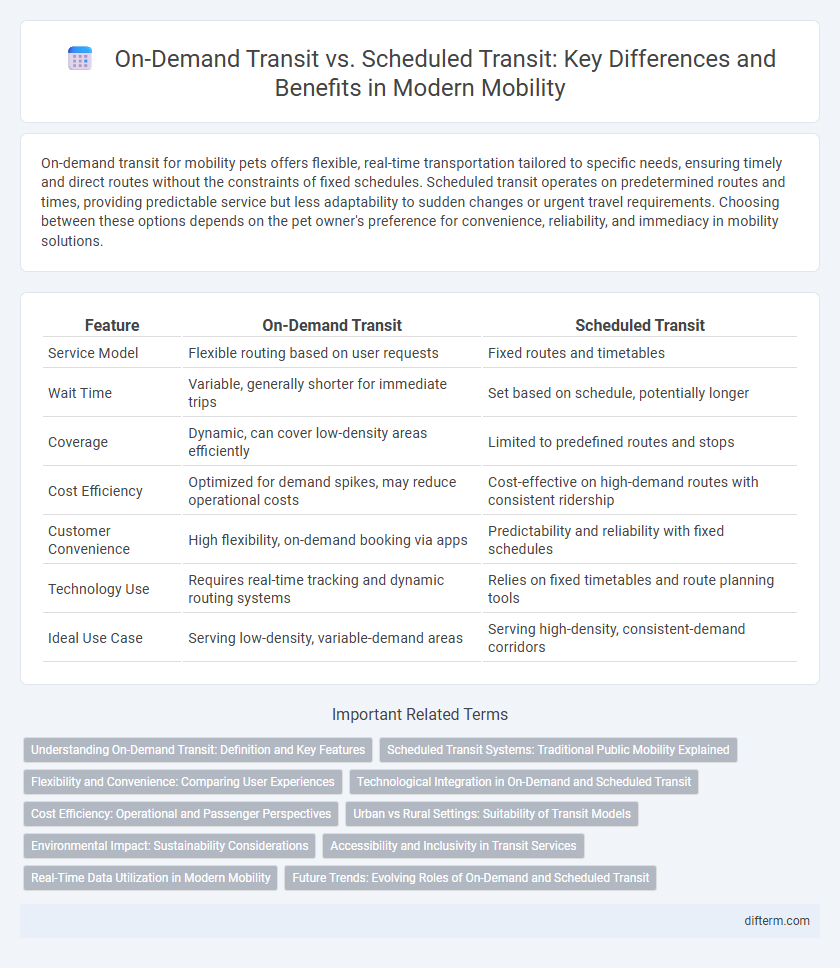On-demand transit for mobility pets offers flexible, real-time transportation tailored to specific needs, ensuring timely and direct routes without the constraints of fixed schedules. Scheduled transit operates on predetermined routes and times, providing predictable service but less adaptability to sudden changes or urgent travel requirements. Choosing between these options depends on the pet owner's preference for convenience, reliability, and immediacy in mobility solutions.
Table of Comparison
| Feature | On-Demand Transit | Scheduled Transit |
|---|---|---|
| Service Model | Flexible routing based on user requests | Fixed routes and timetables |
| Wait Time | Variable, generally shorter for immediate trips | Set based on schedule, potentially longer |
| Coverage | Dynamic, can cover low-density areas efficiently | Limited to predefined routes and stops |
| Cost Efficiency | Optimized for demand spikes, may reduce operational costs | Cost-effective on high-demand routes with consistent ridership |
| Customer Convenience | High flexibility, on-demand booking via apps | Predictability and reliability with fixed schedules |
| Technology Use | Requires real-time tracking and dynamic routing systems | Relies on fixed timetables and route planning tools |
| Ideal Use Case | Serving low-density, variable-demand areas | Serving high-density, consistent-demand corridors |
Understanding On-Demand Transit: Definition and Key Features
On-demand transit is a flexible transportation service that allows passengers to request rides in real-time through mobile apps or call centers, differing from traditional scheduled transit that operates on fixed routes and timetables. Key features include dynamic routing, reduced wait times, and adaptability to fluctuating demand, enhancing efficiency in low-density or underserved areas. This service integrates technology-driven dispatching systems to optimize trip allocation and vehicle utilization, improving overall mobility and accessibility.
Scheduled Transit Systems: Traditional Public Mobility Explained
Scheduled transit systems operate on fixed routes and timetables, providing reliable and predictable public transportation options for commuters. These systems optimize resource allocation and infrastructure usage by maintaining consistent service intervals, facilitating efficient planning and accessibility. Public agencies leverage scheduled transit to support urban mobility, reduce traffic congestion, and promote sustainable transportation alternatives.
Flexibility and Convenience: Comparing User Experiences
On-demand transit offers greater flexibility by allowing users to request rides in real-time, accommodating spontaneous travel needs and reducing wait times compared to fixed-route scheduled transit. Scheduled transit operates on predetermined routes and timetables, providing predictability but less adaptability to individual user schedules. Users often find on-demand services more convenient for last-mile connectivity and trips outside peak hours, enhancing overall mobility and accessibility.
Technological Integration in On-Demand and Scheduled Transit
On-demand transit leverages real-time data, GPS tracking, and AI-powered dispatch systems to optimize routes dynamically, significantly enhancing efficiency and user convenience compared to scheduled transit. Scheduled transit relies on fixed timetables and routes, using technology primarily for predictive maintenance and passenger information systems rather than route flexibility. The integration of mobile apps and automated payment platforms in on-demand transit further streamlines rider experience and operational adaptability versus the more rigid traditional transit models.
Cost Efficiency: Operational and Passenger Perspectives
On-demand transit reduces operational costs by optimizing vehicle routes and minimizing idle time compared to scheduled transit, leading to lower fuel consumption and maintenance expenses. From a passenger perspective, flexible pick-up and drop-off options decrease wait times and improve affordability by charging based on distance traveled rather than fixed fares. Studies indicate that cities implementing on-demand transit experience up to 30% savings in operational costs and a 20% increase in passenger satisfaction related to cost efficiency.
Urban vs Rural Settings: Suitability of Transit Models
On-demand transit offers greater flexibility and cost efficiency in rural settings where population density is low and fixed routes may be underutilized, improving accessibility for dispersed communities. Scheduled transit is more suitable for urban areas with high population density and predictable travel patterns, enabling efficient resource allocation and reliable service frequency. Balancing these models depends on factors such as ridership demand, infrastructure, and budget constraints specific to urban or rural environments.
Environmental Impact: Sustainability Considerations
On-demand transit significantly reduces environmental impact by optimizing vehicle routes and minimizing empty miles, leading to lower greenhouse gas emissions compared to scheduled transit systems that often run fixed routes regardless of passenger load. Studies indicate that on-demand services can reduce carbon footprints by up to 30% through enhanced efficiency and dynamic demand responsiveness. These sustainability benefits position on-demand transit as a vital strategy for cities aiming to meet climate goals and reduce urban pollution.
Accessibility and Inclusivity in Transit Services
On-demand transit enhances accessibility by providing flexible routing and scheduling tailored to individual passenger needs, which is especially beneficial for people with disabilities and those in underserved areas. Scheduled transit often has fixed routes and times, potentially limiting access for users with varying mobility requirements or unpredictable schedules. Integrating on-demand options with traditional services promotes inclusivity, ensuring broader community access to essential transportation.
Real-Time Data Utilization in Modern Mobility
On-demand transit leverages real-time data to dynamically optimize routes and schedules, enhancing efficiency and reducing wait times for passengers. Scheduled transit primarily relies on fixed timetables with limited real-time adjustments, often leading to less flexibility and potential delays. Integration of GPS tracking, passenger demand analytics, and traffic conditions in on-demand services results in a more responsive and adaptive mobility solution.
Future Trends: Evolving Roles of On-Demand and Scheduled Transit
On-demand transit is expected to complement scheduled transit by providing flexible first-mile and last-mile solutions, enhancing overall network efficiency and user convenience. Advances in AI and real-time data analytics enable dynamic routing for on-demand services, optimizing vehicle utilization and reducing wait times. Scheduled transit remains essential for high-capacity corridors, but its integration with on-demand options will define future multimodal mobility ecosystems.
on-demand transit vs scheduled transit Infographic

 difterm.com
difterm.com